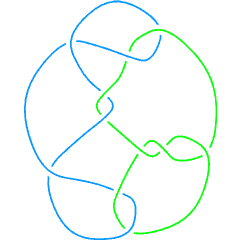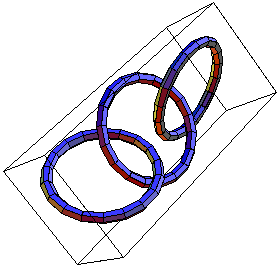0708-1300/Homework Assignment 6: Difference between revisions
No edit summary |
No edit summary |
||
| Line 1: | Line 1: | ||
{{0708-1300/Navigation}} |
{{0708-1300/Navigation}} |
||
{{In Preparation}} |
|||
==Reading== |
==Reading== |
||
At your leisure, read your class notes over the break, and especially at some point right before classes resume |
At your leisure, read your class notes over the break, and especially at some point right before classes resume next semester. Here are a few questions you can ask yourself while reading: |
||
* Do you understand pullbacks of differential forms? |
|||
* Do you think you could in practice integrate any differential form on any manifold (at least when the formulas involved are not too messy)? |
|||
* Do you understand orientations and boundaries and how they interact? |
|||
* Why is Stokes' theorem true? Both in terms of the local meaning of <math>d</math>, and in terms of a formal proof. |
|||
* Do you understand the two and three dimensional cases of Stokes' theorem? |
|||
* Do you understand the Hodge star operator <math>\star</math>? |
|||
* How did we get <math>d\star dA=J</math> from the least action principle? |
|||
* Do you understand how Poincare's lemma entered the derivation of Maxewell's equations? |
|||
* Do you understand the operator <math>P</math>? (How was it used, formally derived, and what is the intuitive picture behind it?) |
|||
* What was <math>H_{dR}</math> and how did it relate to pullbacks and homotopy. |
|||
==Doing== |
==Doing== |
||
Solve the following problems and submit your solutions of problems 1, 3 and 4. This is a very challenging collection of problems; I expect most of you to do problem 2 with no difficulty (it is a repeat of an older problem), problem 1 with |
Solve the following problems and submit your solutions of problems 1, 3 and 4. This is a very challenging collection of problems; I expect most of you to do problem 2 with no difficulty (it is a repeat of an older problem), problem 1 with some effort, and I hope each of you will be able to do at least one further problem. It will be great if some of you will do all problems! |
||
'''Problem 1.''' If <math>M</math> is a compact orientable <math>n</math>-manifold with no boundary, show that <math>H^n_{dR}(M)\neq 0</math>. |
'''Problem 1.''' If <math>M</math> is a compact orientable <math>n</math>-manifold with no boundary, show that <math>H^n_{dR}(M)\neq 0</math>. |
||
| Line 11: | Line 20: | ||
'''Problem 2.''' The standard volume form on <math>S^2</math> is the form <math>\omega</math> given by <math>\omega=\frac{1}{4\pi}\left(xdy\wedge dz+ydz\wedge dx+zdx\wedge dy\right)</math>. Show that <math>\int_{S^2}\omega=1</math>. |
'''Problem 2.''' The standard volume form on <math>S^2</math> is the form <math>\omega</math> given by <math>\omega=\frac{1}{4\pi}\left(xdy\wedge dz+ydz\wedge dx+zdx\wedge dy\right)</math>. Show that <math>\int_{S^2}\omega=1</math>. |
||
'''Problem 3.''' Show that if <math>\omega\in\Omega^2(S^2)</math> satisfies <math>\int_{S_2}\omega=0</math>, then <math>\omega</math> is exact |
'''Problem 3.''' Show that if <math>\omega\in\Omega^2(S^2)</math> satisfies <math>\int_{S_2}\omega=0</math>, then <math>\omega</math> is exact. Deduce that if <math>w_1\in\Omega^2(S^2)</math> and <math>w_2\in\Omega^2(S^2)</math> satisfy <math>\int_{S_2}\omega_1=\int_{S_2}\omega_2</math>, then <math>[\omega_1]=[\omega_2]</math> as elements of <math>H^2_{dR}(S^2)</math>. Deduce further that <math>\dim H^2_{dR}(S^2)=1</math>. |
||
'''Problem 4.''' A "link" in <math>{\mathbb R}^3</math> is an ordered pair <math>\gamma=(\gamma_1, \gamma_2)</math>, in which <math>\gamma_1</math> and <math>\gamma_2</math> are smooth embeddings of the circle <math>S^1</math> into <math>{\mathbb R}^3</math>, whose images (called "the components of <math>\gamma</math>") are disjoint. Two such links are called "isotopic", if one can be deformed to the other via a smooth homotopy along which the components remain embeddings and remain disjoint. Given a link <math>\gamma</math>, define a map <math>\Phi_\gamma:S^1\times S^1\to S^2</math> by <math>\Phi_\gamma(t_1,t_2):=\frac{\gamma_2(t_2)-\gamma_1(t_1)}{||\gamma_2(t_2)-\gamma_1(t_1)||}</math>. Finally, let <math>\omega</math> be the standard volume form of <math>S^2</math>, and define "the linking number of <math>\gamma=(\gamma_1, \gamma_2)</math>" to be <math>l(\gamma)=l(\gamma_1,\gamma_2):=\int_{S^1\times S^1}\Phi_\gamma^\star\omega</math>. Show |
'''Problem 4.''' A "link" in <math>{\mathbb R}^3</math> is an ordered pair <math>\gamma=(\gamma_1, \gamma_2)</math>, in which <math>\gamma_1</math> and <math>\gamma_2</math> are smooth embeddings of the circle <math>S^1</math> into <math>{\mathbb R}^3</math>, whose images (called "the components of <math>\gamma</math>") are disjoint. Two such links are called "isotopic", if one can be deformed to the other via a smooth homotopy along which the components remain embeddings and remain disjoint. Given a link <math>\gamma</math>, define a map <math>\Phi_\gamma:S^1\times S^1\to S^2</math> by <math>\Phi_\gamma(t_1,t_2):=\frac{\gamma_2(t_2)-\gamma_1(t_1)}{||\gamma_2(t_2)-\gamma_1(t_1)||}</math>. Finally, let <math>\omega</math> be the standard volume form of <math>S^2</math>, and define "the linking number of <math>\gamma=(\gamma_1, \gamma_2)</math>" to be <math>l(\gamma)=l(\gamma_1,\gamma_2):=\int_{S^1\times S^1}\Phi_\gamma^\star\omega</math>. Show |
||
Revision as of 09:39, 6 December 2007
| ||||||||||||||||||||||||||||||||||||||||||||||||||||||||||||||||||||||||||||||||||||||||||||||||||||||||||||
Reading
At your leisure, read your class notes over the break, and especially at some point right before classes resume next semester. Here are a few questions you can ask yourself while reading:
- Do you understand pullbacks of differential forms?
- Do you think you could in practice integrate any differential form on any manifold (at least when the formulas involved are not too messy)?
- Do you understand orientations and boundaries and how they interact?
- Why is Stokes' theorem true? Both in terms of the local meaning of , and in terms of a formal proof.
- Do you understand the two and three dimensional cases of Stokes' theorem?
- Do you understand the Hodge star operator ?
- How did we get from the least action principle?
- Do you understand how Poincare's lemma entered the derivation of Maxewell's equations?
- Do you understand the operator ? (How was it used, formally derived, and what is the intuitive picture behind it?)
- What was and how did it relate to pullbacks and homotopy.
Doing
Solve the following problems and submit your solutions of problems 1, 3 and 4. This is a very challenging collection of problems; I expect most of you to do problem 2 with no difficulty (it is a repeat of an older problem), problem 1 with some effort, and I hope each of you will be able to do at least one further problem. It will be great if some of you will do all problems!
Problem 1. If is a compact orientable -manifold with no boundary, show that .
Problem 2. The standard volume form on is the form given by . Show that .
Problem 3. Show that if satisfies , then is exact. Deduce that if and satisfy , then as elements of . Deduce further that .
Problem 4. A "link" in is an ordered pair , in which and are smooth embeddings of the circle into , whose images (called "the components of ") are disjoint. Two such links are called "isotopic", if one can be deformed to the other via a smooth homotopy along which the components remain embeddings and remain disjoint. Given a link , define a map by . Finally, let be the standard volume form of , and define "the linking number of " to be . Show
- If two links and are isotopic, then their linking numbers are the same: .
- If is a second 2-form on for which and if is defined in the same manner as except replacing with , then . (In particular this is true if is very close to a -function form at the north pole of ).
- Compute (but just up to an overall sign) the linking number of the link L11a193, displayed below:

|

|

|
| The links L11a193, and . | ||
Just for Fun
Prove that the two (3-component) links and shown above are not isotopic, yet their complements are diffeomorphic. (See more at Classes: 2004-05: Math 1300Y - Topology: Homework Assignment 5)
Due Date
This assignment is due in class on Thursday January 10, 2007.


















![{\displaystyle [\omega _{1}]=[\omega _{2}]}](https://wikimedia.org/api/rest_v1/media/math/render/svg/6a072623e3514df1499ca42d8c579fc667748e42)




















